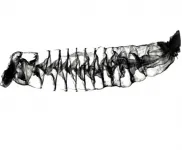(Press-News.org) An adhesive tape patented by Staffordshire University researchers to recover trace evidence from crimes scenes is being adopted to analyse microplastics more efficiently.
Man-made polymer particles or ‘microplastics’ are proven to be present in land, air and water environments. However, despite extensive global studies, there is no standardised approach for their collection and analysis.
Currently, studies regularly involve retrieving microplastic samples from water using a filtration method. Samples are commonly analysed in situ on the filter or after removal from it by hand, which is time consuming and risks accidental loss of the particles and cross contamination.
Claire Gwinnett, Professor of Forensic and Environmental Science, is part of the team that created Easylift® tape more than a decade ago and has more recently applied her expertise in fibre analysis to microplastics.
She explained: “Easylift® tape was developed for the forensic market. However, what we have found is that the same benefits are true when looking at particulates from any environment.
“We realised that it holds great potential for microplastics work particularly when you are out in the field, for example on a boat or on a beach, where the risk of losing or contaminating your microplastic samples is huge.”
A new paper, published in Environmental Advances, addresses the shortcomings of current research methods and sets out a new workflow using Easylift® tape. The technique uses the self-adhesive tape to ‘lift’ microplastic particles from a filter then safely preserves them between the tape and a sheet of suitable material – in this case glass.
This method was trialled by Professor Gwinnett during an expedition to collect microplastic samples along the Hudson River in New York with the Rozalia Project where it proved highly effective, with a mean fibre recovery rate of 96.4%. It also enables multiple analytical techniques to be applied to the samples afterwards and preserves them for future study.
Professor Gwinnett said: “The ultimate goal is that this will become the standardised workflow for microplastics research across the world. At the moment, scientists are extrapolating data and it is only through constant monitoring that we will we truly know how much microplastic pollution is out there. If there is a standardised method to globally track microplastics then we can much better understand the risks and where we should be targeting our efforts for mitigation.
“We know plastic pollution is widespread, but we need to understand how much is in different locations, where it has come from and where it is going. What we need is a global collaborative effort to gather that large-scale data.”
Easylift® tape is already being employed more widely and was used to collect microplastic samples during a transatlantic sailing expedition on former racing vessel the SV Jolokia last year. The Marine Education Centre based in New York State is also training ‘citizen scientists’ to take samples from the Hudson River and other locations using the tape.
Staffordshire University is now collaborating with the University of Oxford and Nekton Mission to analyse microplastic samples from an expedition to the Antarctic where these particulates will be retrieved from ice cores using Easylift® tape.
Professor Gwinnett added: “We need the ability for people to constantly monitor plastic pollution without massive expertise and the beauty of Easylift® is that it can be used by anyone – volunteers, sailing crews, people working in waste-water management can all use this in a robust way.
“It will allow us to share microplastic samples with partner institutions across the world for further analysis and to validate research methods. As with evidence recovered from crime scenes, we will also be able to store microplastic samples to be re-examined in a decade’s time or longer. Being able to collaborate and share research in this way is an exciting step forward.”
Read the full paper The application of tape lifting for microplastic pollution monitoring in Environmental Advances.
Crime scene tape set to revolutionize microplastics research
Forensic scientists have developed a new method to help monitor plastic pollution across the world.
2021-07-21
ELSE PRESS RELEASES FROM THIS DATE:
Smartphone gaming can be harmful for some seeking relief from boredom
2021-07-21
Smartphone gaming can be harmful to players who game to escape their negative mood and feelings of boredom, a new study has found.
Researchers at the University of Waterloo found that bored "escape players"--those who have difficulty engaging with the real environment and sustaining attention--may seek "flow," which is a deep and effortless state of concentration in an activity linked to loss of awareness of time and space.
"We found that people who experience intense boredom frequently in everyday life reported playing smartphone games to escape or alleviate these feelings ...
Tiny organisms shed big light on ocean nutrients
2021-07-21
As the world warms, sweeping changes in marine nutrients seem like an expected consequence of increased ocean temperatures. However, the reality is more complicated. New research suggests that processes below the ocean surface may be controlling what is happening above.
Plankton are some of the most numerous and important organisms in the ocean. The balance of chemical elements inside them varies and is critical to shaping many marine processes, including the food web and the global carbon cycle. Temperature has been traditionally thought to control the ratio of these elements. However, a new study suggests this balance is largely dependent on activity in the subsurface ...
Urgent need for anti-smoking campaigns to continue after pregnancy
2021-07-21
Curtin University research has found quit support for smoking mothers should continue even after their first babies are born, given that many of those women will become pregnant again, and that quitting can substantially reduce the risk of future preterm births.
The longitudinal study examined the records and histories across 23 years, of 63,540 Australian women with more than one child, who smoked during their first pregnancy.
Lead researcher, Professor Gavin Pereira form Curtin's School of Population Health said more than one third of women who smoked during pregnancy were able to stop smoking ...
DNA from 93-year-old butterfly confirms the first US case of human-led insect extinction
2021-07-21
The Xerces blue butterfly was last seen flapping its iridescent periwinkle wings in San Francisco in the early 1940s. It's generally accepted to be extinct, the first American insect species destroyed by urban development, but there are lingering questions about whether it was really a species to begin with, or just a sub-population of another common butterfly. In a new study in Biology Letters, researchers analyzed the DNA of a 93-year-old Xerces blue specimen in museum collections, and they found that its DNA is unique enough to merit being considered a species. The study confirms that yes, the Xerces blue really ...
Women's heart health is strongly related to pregnancy outcomes
2021-07-21
Sophia Antipolis, 21 July 2021: A study of more than 18 million pregnancies has shown a strong and graded relationship between women's heart health and pregnancy outcomes. The research is published today in the European Journal of Preventive Cardiology, a journal of the European Society of Cardiology (ESC).1
The researchers examined the presence of four risk factors for cardiovascular disease in women prior to pregnancy: unhealthy body weight, smoking, hypertension and diabetes. The likelihood of key pregnancy complications - maternal intensive care unit (ICU) admission, preterm birth, low birthweight and foetal death - rose incrementally with the number of pre-pregnancy cardiovascular risk factors.
"Individual cardiovascular risk factors, such as obesity and hypertension, present ...
Planetary shields will buckle under stellar winds from their dying stars
2021-07-21
Any life identified on planets orbiting white dwarf stars almost certainly evolved after the star's death, says a new study led by the University of Warwick that reveals the consequences of the intense and furious stellar winds that will batter a planet as its star is dying. The research is published in Monthly Notices of the Royal Astronomical Society, and lead author Dr Dimitri Veras will present it today (21 July) at the online National Astronomy Meeting (NAM 2021).
The research provides new insight for astronomers searching for signs of life around these dead stars by examining the impact that their ...
SuperBIT: A low-cost balloon-borne telescope to rival Hubble
2021-07-21
Durham, Toronto and Princeton Universities have teamed up with NASA and the Canadian Space Agency to build a new kind of astronomical telescope. SuperBIT flies above 99.5% of the Earth's atmosphere, carried by a helium balloon the size of a football stadium. The telescope will make its operational debut next April and when deployed should obtain high-resolution images rivalling those of the Hubble Space Telescope. Mohamed Shaaban, a PhD student at the University of Toronto, will describe SuperBIT in his talk today (Wednesday 21 July) at the online RAS National Astronomy Meeting (NAM 2021).
Light from a distant galaxy can travel for billions of years to reach our telescopes. In the final ...
Thinking about getting pregnant? First check your risks for heart disease
2021-07-21
CHICAGO --- A woman's heart health before she becomes pregnant is strongly related to her likelihood of experiencing a complication during her pregnancy or labor, reports a new Northwestern Medicine study.
The study examined the presence of four cardiovascular risk factors in women before they became pregnant: smoking, unhealthy body weight, hypertension and diabetes. With the presence of each additional risk factor, the likelihood that the woman would experience an adverse pregnancy outcome got increasingly higher. Those adverse outcomes include maternal intensive care unit (ICU) admission, preterm birth, low birthweight and fetal ...
New 3D images of shark intestines show they function like Nikola Tesla's valve
2021-07-21
Contrary to what popular media portrays, we actually don't know much about what sharks eat. Even less is known about how they digest their food, and the role they play in the larger ocean ecosystem.
For more than a century, researchers have relied on flat sketches of sharks' digestive systems to discern how they function -- and how what they eat and excrete impacts other species in the ocean. Now, researchers have produced a series of high-resolution, 3D scans of intestines from nearly three dozen shark species that will advance the understanding of how sharks eat and digest their food.
"It's high time ...
More exercise and fewer hours watching TV cuts sleep apnoea risk
2021-07-21
Being more physically active and spending fewer hours per day sitting watching TV is linked to a substantially lower risk of developing obstructive sleep apnoea (OSA), according to new research published in the European Respiratory Journal [1]. It is the first study to simultaneously evaluate physical activity and sedentary behaviour in relation to OSA risk.
OSA is a condition where breathing stops and starts many times during sleep. It reduces oxygen levels in the blood and common symptoms include snoring, disrupted sleep and feeling excessively tired. ...
LAST 30 PRESS RELEASES:
Making lighter work of calculating fluid and heat flow
Normalizing blood sugar can halve heart attack risk
Lowering blood sugar cuts heart attack risk in people with prediabetes
Study links genetic variants to risk of blinding eye disease in premature infants
Non-opioid ‘pain sponge’ therapy halts cartilage degeneration and relieves chronic pain
AI can pick up cultural values by mimicking how kids learn
China’s ecological redlines offer fast track to 30 x 30 global conservation goal
Invisible indoor threats: emerging household contaminants and their growing risks to human health
Adding antibody treatment to chemo boosts outcomes for children with rare cancer
Germline pathogenic variants among women without a history of breast cancer
Tanning beds triple melanoma risk, potentially causing broad DNA damage
Unique bond identified as key to viral infection speed
Indoor tanning makes youthful skin much older on a genetic level
Mouse model sheds new light on the causes and potential solutions to human GI problems linked to muscular dystrophy
The Journal of Nuclear Medicine ahead-of-print tip sheet: December 12, 2025
Smarter tools for peering into the microscopic world
Applications open for funding to conduct research in the Kinsey Institute archives
Global measure underestimates the severity of food insecurity
Child survivors of critical illness are missing out on timely follow up care
Risk-based vs annual breast cancer screening / the WISDOM randomized clinical trial
University of Toronto launches Electric Vehicle Innovation Ontario to accelerate advanced EV technologies and build Canada’s innovation advantage
Early relapse predicts poor outcomes in aggressive blood cancer
American College of Lifestyle Medicine applauds two CMS models aligned with lifestyle medicine practice and reimbursement
Clinical trial finds cannabis use not a barrier to quitting nicotine vaping
Supplemental nutrition assistance program policies and food insecurity
Switching immune cells to “night mode” could limit damage after a heart attack, study suggests
URI-based Global RIghts Project report spotlights continued troubling trends in worldwide inhumane treatment
Neutrophils are less aggressive at night, explaining why nighttime heart attacks cause less damage than daytime events
Menopausal hormone therapy may not pose breast cancer risk for women with BRCA mutations
Mobile health tool may improve quality of life for adolescent and young adult breast cancer survivors
[Press-News.org] Crime scene tape set to revolutionize microplastics researchForensic scientists have developed a new method to help monitor plastic pollution across the world.





